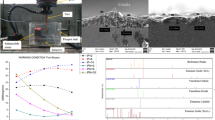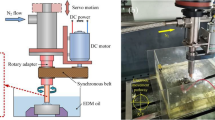Abstract
Pulsed electrochemical machining (PECM) has attracted increasing interest as a technique to improve material dissolution localization and surface quality. This work systematically investigates the effects of pulse current on the surface morphology, profile accuracy, and corrosion behavior of Inconel 718 (IN718) in NaNO3 solution. Polarization behavior reveals that IN718 in NaNO3 solution during pulse current machining exhibited significant passive, transpassive, and re-passive characteristics. The passive film generated at the re-passive state contained some oxides and had a loose porous structure. The critical value for the quantity of electric charge to rupture the passive film was determined to be 26.88 C cm−2. The current efficiency indicates that the material removal rate of IN718 in NaNO3 solution during pulse current machining was nonlinear. The PECM experiments indicate that the loading process of the electrical double layer was prolonged with an increased workpiece scale, i.e., the loading process of the electrical double layer lasted for the entire pulse-on time when the workpiece scale was 100 mm2 at a frequency of more than 10 kHz regardless of the duty cycle. A pulse current with a short pulse length and short pulse period improved the profile accuracy, as did the low applied voltage and small workpiece scale. The dissolution mechanism of IN718 in NaNO3 solution was also investigated based on the effective pulse current time. Finally, the leading-edge structure of a ruled blade with good dimensional accuracy and surface quality was successfully fabricated. The maximum deviations of the machined profile were effectively restricted within 0.057 mm, and the surface roughness was Ra = 0.358 µm.
Similar content being viewed by others
References
Cao W J, Wang D Y, Cui G W, et al. Anodic dissolution mechanism of TA15 titanium alloy during counter-rotating electrochemical machining. Sci China Tech Sci, 2022, 65: 1253–1262
Wang Y D, Xu Z Y, Zhang A, et al. Surface morphology and electrochemical behaviour of Ti-48Al-2Cr-2Nb alloy in low-concentration salt solution. Sci China Tech Sci, 2020, 64: 283–296
Xu Z, Wang Y. Electrochemical machining of complex components of aero-engines: Developments, trends, and technological advances. Chin J Aeronaut, 2021, 34: 28–53
Wang J, Xu Z, Wang J, et al. Anodic dissolution characteristics of Inconel 718 in C6H5K3O7 and NaNO3 solutions by pulse electrochemical machining. Corrosion Sci, 2021, 183: 109335
Thakur A, Gangopadhyay S. State-of-the-art in surface integrity in machining of nickel-based super alloys. Int J Mach Tools Manuf, 2015, 100: 25–54
Schuster R, Kirchner V, Allongue P, et al. Electrochemical micromachining. Science, 2000, 289: 98–101
Davydov A D, Volgin V M. Electrochemical machining. In: Bard A J, Stratmann M, eds. Encyclopedia of Electrochemistry, 5. Weinheim: Wiley-VCH, 2007. 809–854
Sueptitz R, Dunne P, Tschulik K, et al. Electrochemical micromachining of passive electrodes. Electrochim Acta, 2013, 109: 562–569
Vladimir M V, Victor V L, Tatyana B K, et al. Theoretical analysis of micro/nano electrochemical machining with ultra-short voltage pulses. Electrochim Acta, 2021, 369: 137666
Kozak J, Gulbinowicz D, Glubinowicz Z. The mathematical modeling and computer simulation of pulse electrochemical micromachining. Eng Lett, 2008, 16: 556–561
Mithu M A H, Fantoni G, Ciampi J. The effect of high frequency and duty cycle in electrochemical microdrilling. Int J Adv Manuf Technol, 2011, 55: 921–933
Hotoiu E L, Van Damme S, Albu C, et al. Simulation of nano-second pulsed phenomena in electrochemical micromachining processes — Effects of the signal and double layer properties. Electrochim Acta, 2013, 93: 8–16
Rosenkranz C, Lohrengel M M, Schultze J W. The surface structure during pulsed ECM of iron in NaNO3. Electrochim Acta, 2005, 50: 2009–2016
Meng L, Zeng Y, Fang X, et al. Micropatterning of Ni-based metallic glass by pulsed wire electrochemical micro machining. Intermetallics, 2017, 81: 16–25
Favaro M, Jeong B, Ross P N, et al. Unravelling the electrochemical double layer by direct probing of the solid/liquid interface. Nat Commun, 2016, 7: 12695
Chen W, Han F, Wang J. Influence of pulse waveform on machining accuracy in electrochemical machining. Int J Adv Manuf Technol, 2018, 96: 1367–1375
Luo J, Qi X, Fang X, et al. Electrochemical machining of microgrooves on flexible metallic foil using a tungsten arrayed microtool. CIRP J Manuf Sci Tech, 2021, 35: 604–614
Fang X, Han Z, Chen M, et al. Pulse-current wire electrochemical machining with axial electrolyte flushing along a rotating helical wire tool. J Electrochem Soc, 2020, 167: 113503
Ahn S H, Ryu S H, Choi D K, et al. Electro-chemical micro drilling using ultra short pulses. Precis Eng, 2004, 28: 129–134
Rajurkar K P, Zhu D, McGeough J A, et al. New developments in electro-chemical machining. CIRP Ann, 1999, 48: 567–579
Anderson M, Thielin A L, Bridier F, et al. δ Phase precipitation in Inconel 718 and associated mechanical properties. Mater Sci Eng-A, 2017, 679: 48–55
Khomenko V, Frackowiak E, Béguin F. Determination of the specific capacitance of conducting polymer/nanotubes composite electrodes using different cell configurations. Electrochim Acta, 2005, 50: 2499–2506
Stoller M D, Ruoff R S. Best practice methods for determining an electrode material’s performance for ultracapacitors. Energy Environ Sci, 2010, 3: 1294–1301
Popovich V A, Borisov E V, Popovich A A, et al. Impact of heat treatment on mechanical behaviour of Inconel 718 processed with tailored microstructure by selective laser melting. Mater Des, 2017, 131: 12–22
You X, Tan Y, Zhao L, et al. Effect of solution heat treatment on microstructure and electrochemical behavior of electron beam smelted Inconel 718 superalloy. J Alloys Compd, 2018, 741: 792–803
Luo S, Huang W, Yang H, et al. Microstructural evolution and corrosion behaviors of Inconel 718 alloy produced by selective laser melting following different heat treatments. Addit Manuf, 2019, 30: 100875
Wang D, Zhu Z, Wang N, et al. Investigation of the electrochemical dissolution behavior of Inconel 718 and 304 stainless steel at low current density in NaNO3 solution. Electrochim Acta, 2015, 156: 301–307
Lou H, Dong C F, Li X G, et al. The electrochemical behaviour of 2205 duplex stainless steel in alkaline solutions with different pH in the presence of chloride. Electrochim Acta, 2012, 64: 211–220
Singh V B, Gupta A. Active, passive and transpassive dissolution of In-718 alloy in acidic solutions. Mater Chem Phys, 2004, 85: 12–19
Schneider M, Schubert N, Höhn S, et al. Anodic dissolution behaviour and surface texture development of cobalt under electrochemical machining conditions. Electrochim Acta, 2013, 106: 279–287
Zhu D, Yu L G, Zhang R H. Dissolution effects with different microstructures of Inconel 718 on surface integrity in electrochemical machining. J Electrochem Soc, 2018, 165: E872–E878
Pistorius P C, Burstein G T. Aspects of the effects of electrolyte composition on the occurrence of metastable pitting on stainless steel. Corrosion Sci, 1994, 36: 525–538
Ge Y C, Zhu Z, Wang D. Electrochemical dissolution behavior of the nickel-based cast superalloy K423A in NaNO3 solution. Electrochim Acta, 2017, 253: 379–389
Frangini S, Paoletti C, Della Seta L. Corrosion of inconel alloys for application as inert anodes in low-temperature molten carbonate electrolysis processes. Int J Hydrog Energy, 2021, 46: 14953–14961
Xu Z, Chen X, Zhou Z, et al. Electrochemical machining of high-temperature titanium alloy Ti60. Procedia CIRP, 2016, 42: 125–130
Wang Y, Xu Z, Zhang A. Electrochemical dissolution behavior of Ti−45Al−2Mn−2Nb+0.8 vol% TiB2 XD alloy in NaCl and NaNO3 solutions. Corrosion Sci, 2019, 157: 357–369
Ittah R, Amsellem E, Itzhak D. Pitting corrosion evaluation of titanium in NH4Br solutions by electrochemical methods. Int J Electrochem Sci, 2014, 9: 633–643
Sun M, Wu X, Zhang Z, et al. Analyses of oxide films grown on Alloy 625 in oxidizing supercritical water. J SuperCrit Fluids, 2008, 47: 309–317
Biesinger M C, Payne B P, Grosvenor A P, et al. Resolving surface chemical states in XPS analysis of first row transition metals, oxides and hydroxides: Cr, Mn, Fe, Co and Ni. Appl Surf Sci, 2011, 257: 2717–2730
Zhu X, Zhu Y, Murali S, et al. Nanostructured reduced graphene oxide/Fe2O3 composite as a high-performance anode material for lithium ion batteries. ACS Nano, 2011, 5: 3333–3338
Ren Y, Gong T, Tan S, et al. Photocatalytic activities of g-C3N4, Bi3NbO7 and g-C3N4/Bi3NbO7 in photocatalytic reduction of Cr(VI). J Alloys Compd, 2022, 902: 163752
Oku M, Hirokawa K. X-ray photoelectron spectroscopy of Co3O4, Fe3O4, Mn3O4, and related compounds. J Electron Spectr Relat Phenomena, 1976, 8: 475–481
Liu L, Li Y, Wang F. Influence of micro-structure on corrosion behavior of a Ni-based superalloy in 3.5% NaCl. Electrochim Acta, 2007, 52: 7193–7202
Isaacs H S. The localized breakdown and repair of passive surfaces during pitting. Corrosion Sci, 1989, 29: 313–323
Blasco-Tamarit E, Igual-Muñoz A, Antón J G, et al. Effect of temperature on the corrosion resistance and pitting behaviour of Alloy 31 in LiBr solutions. Corrosion Sci, 2008, 50: 1848–1857
Lohrengel M M, Klüppel I, Rosenkranz C, et al. Microscopic investigations of electrochemical machining of Fe in NaNO3. Electrochim Acta, 2003, 48: 3203–3211
Lohrengel M M, Rataj K P, Münninghoff T. Electrochemical machining-mechanisms of anodic dissolution. Electrochim Acta, 2016, 201: 348–353
Schubert N, Schneider M, Michealis A. The mechanism of anodic dissolution of cobalt in neutral and alkaline electrolyte at high current density. Electrochim Acta, 2013, 113: 748–754
Guo C, Wu B, Xu B, et al. Investigation of pulse electrochemical machining of Zr-based bulk metallic glasses in NaNO3-ethylene glycol electrolyte. J Electrochem Soc, 2021, 168: 071502
Haisch T, Mittemeijer E, Schultze J W. Electrochemical machining of the steel 100Cr6 in aqueous NaCl and NaNO3 solutions: Microstructure of surface films formed by carbides. Electrochim Acta, 2001, 47: 235–241
Liu W, Ao S, Li Y, et al. Effect of anodic behavior on electrochemical machining of TB6 titanium Alloy. Electrochim Acta, 2017, 233: 190–200
Landolt D. Fundamental aspects of electropolishing. Electrochim Acta, 1987, 32: 1–11
Author information
Authors and Affiliations
Corresponding author
Additional information
This work was supported by the National Natural Science Foundation of China (Grant No. 91960204), the National Natural Science Foundation of China for Creative Research Groups (Grant No. 51921003), and the Postgraduate Research & Practice Innovation Program of Jiangsu Province (Grant No. KYCX21_0191). The authors would also like to thank Dr. Lingchao Meng for his help.
Rights and permissions
About this article
Cite this article
Wang, J., Xu, Z., Geng, T. et al. Dependency of the pulsed electrochemical machining characteristics of Inconel 718 in NaNO3 solution on the pulse current. Sci. China Technol. Sci. 65, 2485–2502 (2022). https://doi.org/10.1007/s11431-021-2043-9
Received:
Accepted:
Published:
Issue Date:
DOI: https://doi.org/10.1007/s11431-021-2043-9




